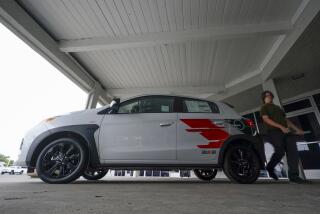Consumer Reports Throws Cold Water on Hot Suzuki Samurai
DETROIT — The Suzuki Samurai, one of the hottest products on the American car market over the past three years, was hit with a devastating public relations blow Thursday from the publishers of Consumer Reports magazine.
Consumers Union, the nonprofit consumer testing organization that publishes Consumer Reports, said it is giving the Japanese four-wheel-drive vehicle the magazine’s first “not acceptable” rating in a decade because of what the group said were basic design flaws that can lead to deadly roll-over accidents.
The group also called on Suzuki to recall all 150,000 Samurais on the road in the United States and refund the purchase price to the owners.
Suzuki officials denied that the Samurai is unsafe, however, and disputed Consumers Union’s findings, to be published in the July issue of Consumer Reports. “We have absolute confidence that we are selling a safe and stable vehicle,” said Doug Mazza, vice president and general manager of Suzuki’s U.S. sales operations in Brea.
“The Samurai was thoroughly tested for safety, including stability and handling prior to its introduction into the United States,” he said.
But Consumers Union believes that the Samurai’s design flaws are so serious that the car was the first of 349 models reviewed over the past 10 years to receive an unacceptable rating, said David C. Berliner, Consumers Union’s assistant director. The last models rated unacceptable were the Plymouth Horizon and Dodge Omni in 1978.
“This is a car that we consider dangerous,” Berliner said, noting that the Samurai appeals to young buyers, who tend to take more risks while driving, which “makes it more scary.”
“The design is inherently flawed in the Samurai,” he said. “It brings together a high center of gravity, a narrow tread width and a light weight, and when you put that together, you come up with a car that poses potentially serious problems for motorists.
“It’s not something where they can make an adjustment, or put on some hardware in order to make a difference,” Berliner added. “As designed, the only solution is to take it off the market.”
The Mount Vernon, N.Y.-based consumer group said it also filed a petition with the National Highway Traffic Safety Administration on Thursday, asking the federal safety agency to begin a full-scale safety investigation of the Samurai, which could lead to a mandatory recall.
Another auto safety watchdog group, the Washington-based Center for Auto Safety, also has recently petitioned the federal government to investigate Samurai roll-overs.
Consumers Union also called on the agency to set new federal safety standards for automotive design that might reduce the risks of roll-over accidents. The federal government currently doesn’t have any rules covering roll-over accidents, according to Ron De Fore, director of public and consumer affairs for the safety agency.
De Fore added that the agency will study the Consumers Union petition before deciding whether to begin an investigation.
Since the Samurai’s 1985 introduction, the federal government has received 44 reports of roll-over accidents involving Samurais, which reportedly caused 16 deaths and 53 injuries. But the agency has not conducted any safety investigations of the problem, and there have been no safety related recalls on the Samurai, De Fore said.
Although De Fore refused to characterize the car as either safe or unsafe, he said the accident statistics for Samurai were “not unusually large numbers” given sales volume of 150,000. Although he did not have accident data for other vehicles like the Samurai, DeFore noted that, of the fatal accidents in 1987 involving Samurais, 63% apparently were alcohol related and only 24% of the victims were wearing seat belts.
“When you have a roll-over and you are not wearing a seat belt, you have a good chance of being ejected, and your chances of being killed are four times greater if you are ejected,” De Fore said.
Still, Consumers Union said its tests showed a dangerous tendency in the Samurai to roll over when performing relatively routine maneuvers and at relatively low speeds.
Consumers Union showed reporters at a New York press conference a videotape of the Samurai traveling at under 40 miles per hour, then lurching onto two wheels and beginning to roll over after making a sudden turn to move around an obstacle. The group showed similar scenes of the Jeep Wrangler, the Jeep Cherokee and the Isuzu Trooper successfully managing the same maneuver at speeds over 40 miles per hour.
R. David Pittle, the Consumers Union’s technical director, told reporters that the Samurai “literally trips over its own feet.”
As soon as it hit the American market in late 1985, the Samurai became a hot, trend-setting product that helped create a whole new market for low-priced, Jeep-type vehicles. It captured the imagination of beach-going young buyers, especially in California and the rest of the Sunbelt; of its total U.S. sales of slightly more than 80,000 last year, more than 15,000 were sold in California.
But with the Japanese yen’s rise against the dollar, Suzuki has been forced to raise Samurai prices by about 30%. The base price on the convertible Samurai has increased from $6,550 in 1985 to $8,495 today. As a result, sales have been slowing over the last few months, and in April, Suzuki sold 6,165 Samurais, down 26% percent from a year ago.






